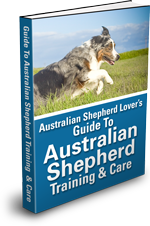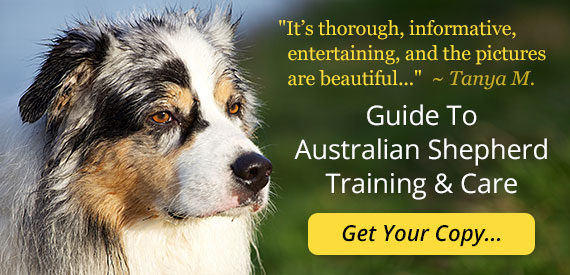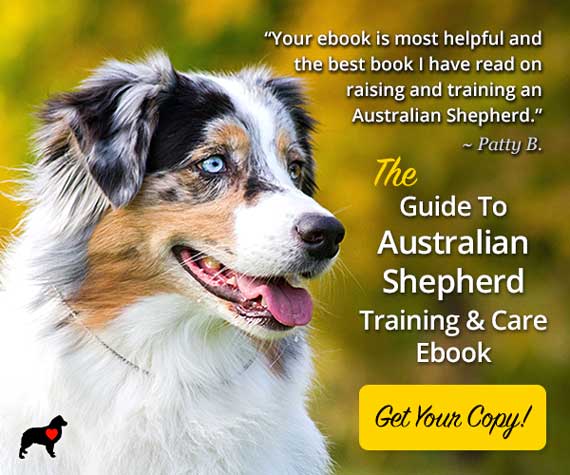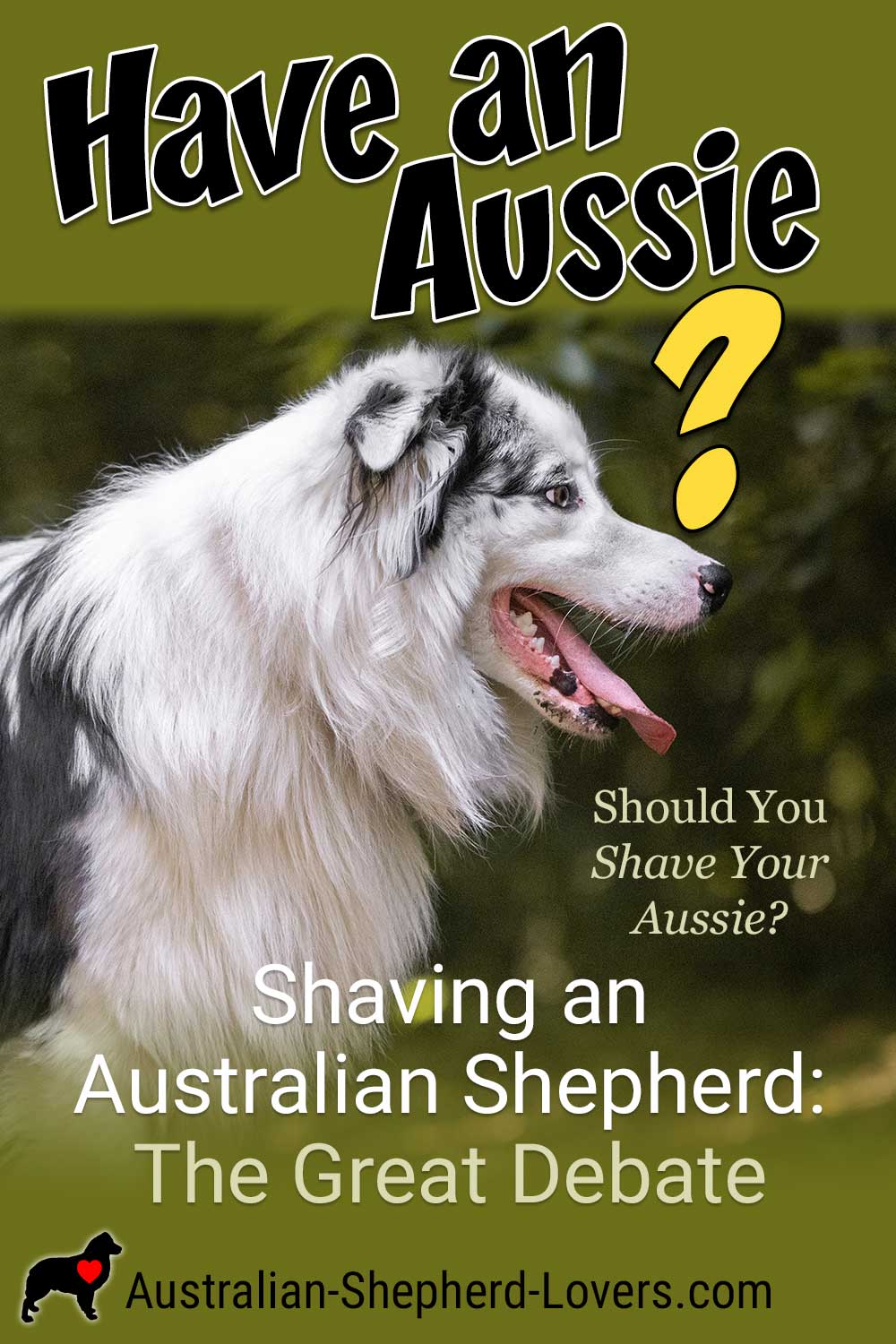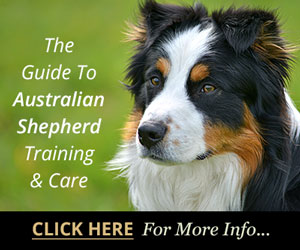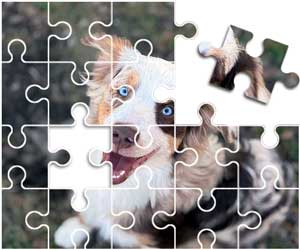
Should I Shave My Australian Shepherd? A Simple Question With A Complex Answer
Shaving an Australian Shepherd is one of the most heated subjects in the dog world, spawning all sorts of debate with both sides passionately defending their side. You may think that deciding whether or not to shave your dog is a simple choice, but the fact is that it can be much more complex than you might realize. The answer to this dilemma goes far beyond a mere "yes" or "no" with many factors figuring in to the final decision.
First of all, what do we mean by "shaving"? We do not mean shaving down to the skin. If you are wondering whether or not to do that, the answer is... "No!"
What we mean by "shaving" is a trim that leaves enough to at least protect the skin from direct sunlight. Some people might call this a "puppy trim" or a "summer cut". This is where the fur is trimmed to a consistent length over the whole body to a length of about an inch or two.
If you decide to get your dog trimmed, be sure to confirm what the groomer means by those terms to make sure you are both on the same page, as some people's definition of those terms could be much different than what you are envisioning.
If you shave a dog's coat too much shorter than that, you are asking for trouble. But should you be shaving your Aussie at all?
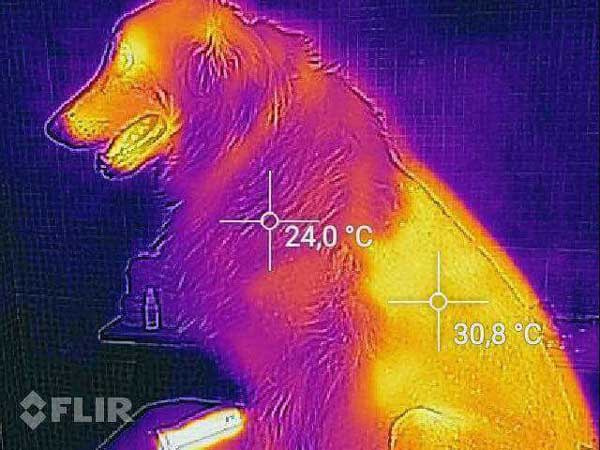
This Dog's Thermal Image Proves Everything(?)
You may have seen the image above floating around the internet that shows a thermal image of a dog. The areas that are shaved have a higher temperature (30.8° C / 87.4° F) and the areas that still have a full coat show a lower temperature (24.0° C / 75.2° F). If you looked no deeper, this would seem to indicate that shaving is bad because it makes dogs hotter. Here's proof. All the shaved areas are hotter!
However, what this image actually shows is just the heat radiating from the dog's own body. Of course, areas that expose the body closer to skin level will show a higher temperature because the heat can be directly detected. The areas with longer fur show a lower temperature just because the fur provides insulation and the temperature at the dogs skin cannot be detected. It just shows the lower temperature of the top level of the fur.
While the ambient temperature can contribute to variations in the measured temperature, thermal images like the one above prove nothing either way.
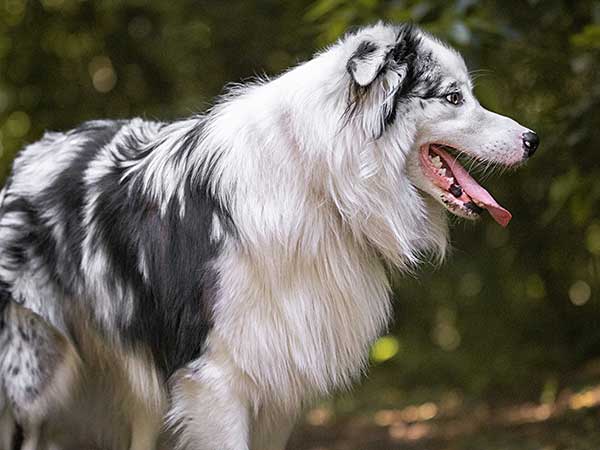
Barbara C / stock.adobe.com
Shaving an Australian Shepherd has pros and cons. There are several factors that need to be taken into account before you make your decision.
Shaving a Double-Coated Dog Like the Aussie
The most common answer when considering shaving an Aussie is usually "no", because shaving, it is claimed, would be detrimental to its health. This is usually backed up with several equally common assertions about Aussie's being a "double-coated" breed and the undercoat being essential for thermoregulation and protection from the sun. All of this sounds relatively practical, but when you look at the facts, the cracks in this theory begin to show through and, while a factor, there are several other considerations to take into account.
First and foremost is the idea of Aussies and certain other breeds being "double-coated", so that shaving an Australian Shepherd would somehow destroy that double coat. All dog breeds have a double coat, consisting of a soft, woolly undercoat and a top coat of "guard hairs". The undercoat keeps the dog warm and the guard hairs protect the undercoat from becoming dirty and wet, which would prevent it from doing its designated job.
The length and texture of the guard hairs can vary depending on the breed, but they perform essentially the same function on all dogs. Some dogs have been bred so it is difficult to distinguish between the guard hair and undercoat, like poodles, or their undercoat is barely visible to the naked eye, with breeds like Yorkies, for example, and may even be considered to be single-coated for all intents and purposes.
Having originated from a now extinct wolf species related to the gray wolf, the dog breeds we know and love today are the result of domestication and breeding over thousands of years. Many traits, including the double coat, were passed down or modified depending on selective breeding for the varying needs of people in diverse locations.
Dogs that lived in arctic areas, with consistently cold temperatures, had thicker undercoats and guard hairs that were shorter and stood on end, while dogs that lived in areas with changing temperatures generally had shorter undercoats and longer, heavier topcoats to protect them from the elements.
Understanding the Cycles of Your Dog's Coat
Once we began transporting the progenitors of dogs out of their natural environments and we started keeping dogs as workers and pets, it meant they needed to adapt to suit their new surroundings. One thing that has never changed, however, is the natural shedding cycle that all dogs experience. Every dog's coat will thin out when the air temperature gets warmer and will thicken up again when it gets colder, which is why dog owners seem to be forever vacuuming up fur.
Shedding and Regrowth
The frustration of dealing with near-constant shedding is one of the things that leads many owners to consider shaving an Aussie, to try and help the process along as best they can and maybe cut down on vacuuming. As tempting as this may be, you need to remember that there are two sides to the cycle and regrowth is equally important for your dog. If you slow the shedding by cutting the dog's coat short, you may also slow the regrowth cycle, meaning your dog will lack the full protective coat he needs in the colder months.
When you think about the natural shedding cycle, it begins to throw some light on the decision about shaving an Australian Shepherd. The built-in signal that the dog is giving is that it requires less hair in the summer and more in the winter. That would seem to give some weight to the argument that shaving your dog in the summer is beneficial. This is true, to an extent, but again, it's not as simple as it sounds.
Undercoat vs Guard Hairs
The different types of hairs actually have different growth cycles. In most cases, the undercoat is shed more regularly and the outer guard hairs have a slower growth cycle and are shed less often. Hair, like other parts of the body, requires proper nutrition to remain healthy. The nutrients that your dog takes in regularly have to work on every body part, so if one part of the body requires more nutrients it will take away from the nutrients other body parts receive.
If a dog lost all of its hair at once, it would require many more nutrients to allow it to grow back, meaning other important body parts like the heart, lungs, and brain would not get all the nutrients they need. Or, as is likely to occur, those organs would get what they need before the skin and hair, so regrowth would be compromised. Instead, the hair is lost at different times so that the nutrients can be more evenly shared among all the body parts.
The Phases of Hair Growth in Dogs: More Than Just Shedding and Regrowth
The cycle of hair growth is complex, and it responds to daylight, temperature, nutrition, hormones, genetics, and overall health, including stress levels. There are also several phases in the cycle, each of which can last for dramatically different lengths of time. Some could take months, others years, and all can vary based on the above-mentioned factors and from season to season, or from one Aussie to another.
- Growth Phase (Anagen) — The time during which a hair is in the process of growing.
- Regressing Phase (Catagen) — The transition from growth stage to when growth has stopped completely.
- Rest Phase (Telogen) — The rest period between the time growth in a hair has stopped and it moves to the next phase.
- Shedding Phase (Exogen) — The most dreaded phase of all when the hairs fall out—everywhere!
- Empty Phase (Kenogen) — The time after the Telogen and Exogen phases and the follicle remains empty before a new Anagen Phase starts the cycle anew.
Add to that the fact that not all hair is at the same point in the cycle; which makes sense as you wouldn't want all the hair to start the shedding cycle at the same time or you'd have a completely hairless dog! In addition, the guard hairs don't grow back at the same rate as the undercoat and are operating on their own cycle.
Shaving an Australian Shepherd Can Put a Strain on Their Body's Resources
By shaving an Aussie, you disrupt that natural cycle and suddenly all the hair is trying to grow back at the same time, which can tax the dog's entire system. This can be particularly tough on older dogs or dogs with health issues that prevent their system from absorbing nutrients properly.
Even if that is not the case, because the coat has been trimmed so that both the undercoat and the guard hairs are the same length and because the undercoat usually grows more quickly, the result can be a patchy looking coat as hair grows in faster in some areas and slower in others. Or the overall appearance could be rough instead of smooth and silky as the undercoat grows beyond the guard hairs and the wooly undercoat protrudes.
While this can leave your dog looking strange for a while, it is more than just a cosmetic issue. The uneven hair regrowth can also leave your dog exposed to the elements or disrupt his ability to regulate body temperature properly. This can be a significant issue depending on an individual dog's particular circumstances.
How Your Dog's Coat Affects Thermoregulation
This brings us to the next common argument against shaving an Australian Shepherd, that doing so will disrupt the thermoregulation process as the undercoat is somehow supposed to help keep the dog cool during the warmer months. While there is some truth to the connection between a dog's coat and its ability to regulate body temperature, once again, it's not as simple as it sounds.
Temperature regulation in dogs is no different than in humans or in any other species. The body has a regular set temperature and when the temperature veers too much from that standard, various systems in the body activate in order to regulate it and get it back to where it's supposed to be. It's much the same way that an air conditioner or furnace works. You set the thermostat for the temperature you want and when the air temperature in the room gets too far off that mark, the cooling or heating system kicks in to bring it back to the desired temperature.
A dog's body gives off heat and also absorbs heat from external sources like the sun, or the heat register, or, even better, by curling up in front of the fireplace. The coat helps to regulate the heat from both internal and external sources in order to keep the dog at a comfortable temperature. The guard hairs in the topcoat can reflect the sun to prevent too much heat from getting to the dog's body or they can be raised in order to allow for more air flow to cool the dog down.
However, both of these functions are limited with a full coat. The outer hairs will slow down heat from transferring down to the undercoat level next to the skin but won't prevent the temperature from rising, eventually. If the dog is just exposed to the sun or other heat sources for short periods of time this may be sufficient, however, any extended exposure will result in overheating.
The undercoat acts as insulation, trapping a layer of air close to the skin, but that layer of air also traps the heat that comes off of the dog's body. So the thicker the undercoat, the warmer the dog will tend to be. That can vary from one dog to the other depending on how active the dog is, but it is the reason all dogs shed as they go into the warmer months, so that they have less hair to block the air circulation that they need to cool down.
It's also the reason why dogs will tend to lay flat against a cool surface, like a tile floor, when they're hot or curl up tightly when they're cold. The cool temperature of the tiles can help to lower the dog's body temperature, especially when it comes in contact with areas of the body where the coat is shorter. Conversely, by curling into a ball the dog can prevent the warm air coming off its body from escaping.
This doesn't mean that shaving a dog won't contribute to a breakdown of the thermoregulation process. It can happen, but the risk varies heavily from one individual dog to another. There is no one rule that covers an entire breed, so it can't be relied on as a base argument against shaving an Aussie. What works for one Aussie may not necessarily work for another.
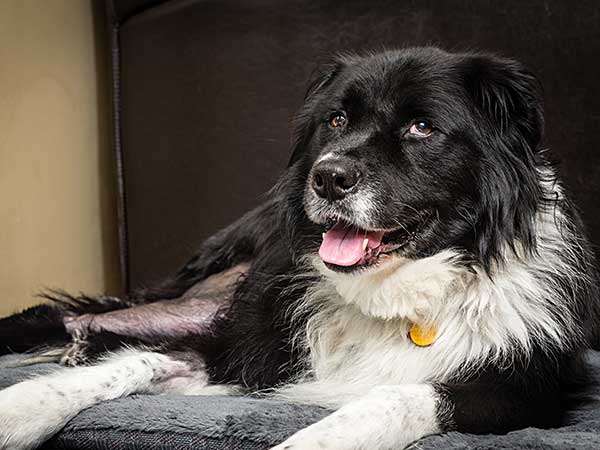
Mary Lynn Strand / stock.adobe.com
It may be necessary to actually shave your Aussie, at least part of them, if they need a medical procedure like this Aussie who is recovering from ACL surgery.
Can Shaving an Australian Shepherd Cause Skin Damage From the Sun?
Another popular argument against shaving an Australian Shepherd is that by cutting their hair short you will increase the threat of damage to the skin from the sun. While skin damage can certainly be an issue particularly for dogs with lighter and shorter coats, like Pit Bulls, Boxers and Dalmatians, for most dogs it wouldn't be an issue unless the coat was clipped extremely short, which rarely happens (unless there was a miscommunication with their groomer).
The extent of concern about your dog's coat protecting it from the sun depends on his particular environment. Does he spend a lot of time outdoors and is there a lot of sun where you live? Is he running around in the open, generating heat through exercise and absorbing it from the sun, or is he lounging in the shade? Or is your dog spending most of his time inside on the couch, where your house would provide natural protection?
When you're considering shaving an Aussie, a big consideration can be the coat providing protection from the elements. Since Aussies are working dogs and may spend a significant portion of their time outdoors on the farm or leading active lifestyles with their families, they might have more exposure to the elements than most dogs. Depending on the weather where you live, that can include sun, rain, wind, or snow. A longer outer coat provides natural protection from these elements, helping to wick away water and preventing the dog from becoming chilled.
That same long outer coat can also provide protection from other potential risks, like brambles, thorns, dirt and even predators. And an active Aussie, who is moving around quite a bit, will have natural ventilation provided by the wind or by the movement of his coat, which will help him remain cool when the temperatures go up.
The Vital Component of Air Flow
The primary functions of a dog's coat are to provide protection from the elements keeping rain, dirt and other nastiness away from the skin, and to hold in heat. Getting calories, and therefore heat, in nature is expensive, so preserving that heat is prioritized. A dog's coat is trying to keep the heat in. It's true that through shedding and thinning out the coat in summer this is somewhat ameliorated, but expelling heat through a full coat is much more difficult than it is with a shorter coat.
Air flow will help heat dissipate, as long as the ambient air is cooler than the air trapped close to the dog's skin. The longer the coat and more thick the undercoat, the more the heat is trapped. Anything you can do to improve air flow the better. If the dog is moving, it will help. If it is windy or a fan is blowing on the dog, it will also help. That is, so long as the ambient air temperature is lower than the temperature of the trapped heat we are trying to dissipate.
If the dog is running, any cooling benefit caused by their movement and air flowing through their coat could be negated by the internal body heat they are generating by exercising. In this case, a dog with shorter hair could cool more efficiently as the external air could more readily reach the warm air next to the dog's skin and lower its temperature (again, assuming the ambient temperature is cooler). If the ambient temperature is warmer and your dog is exposed to the sun while exercising, it is important to avoid heatstroke or exercise induced hyperthermia. Be sure to take breaks in the shade and have plenty of cool water on hand.
If your Aussie has a full coat, it is important that you encourage as much air flow as possible. This can be primarily achieved by making sure they are well brushed as the thicker the undercoat the greater the insulation and the more difficult it is to cool. So, it is especially important in the warm months to brush your Aussie frequently.
When considering shaving an Australian Shepherd, it's important to bear all of those factors in mind.
Does Neutering Dogs Affect Coat Growth?
We can also have a significant impact on coat growth by having our dogs neutered. Neutering can dramatically alter the growth pattern of the coat by changing the dog's hormone levels. Again, it will usually adjust eventually, but it can take a great deal of time and in the meantime, shaving an Aussie can be a real issue because it may take even longer for the coat to grow back.
More Factors to Consider Before Shaving Your Australian Shepherd
So now that we've considered many of the variables, where does this leave us? What you can begin to see here is that the answer about whether shaving an Australian Shepherd is a good idea or not is—it depends. It depends on a lot of different factors and the answer can be different for each individual dog.
Before deciding whether to shave your dog you need to think about the environment where you live, the temperatures your dog is exposed to regularly, whether he spends the bulk of his time outdoors or indoors, and whether or not he gets a lot of exercise. You also need to look at his age, his size, and his overall health.
Older dogs won't be able to regulate their temperatures as easily. Larger dogs will have a bigger layer of fat to insulate them, so they may not need a thick layer of fur for insulation. Dogs with certain health issues may not be able to regulate their body temperature or regrow their coat easily.
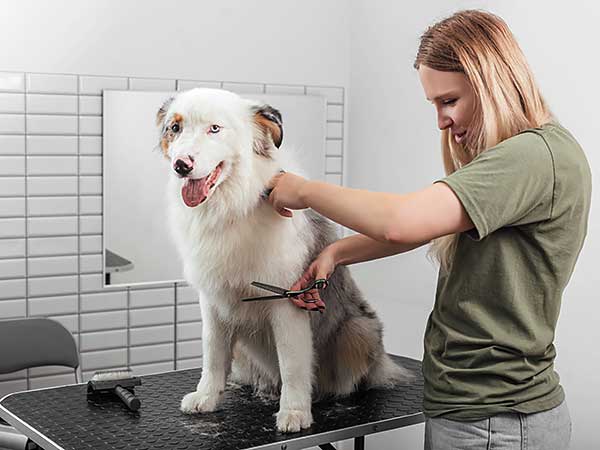
Oleksandr Kozak / stock.adobe.com
I've heard too many horror stories about miscommunications with groomers. Don't assume that either of you understands what the other is saying. Spending a little time at the beginning to make sure you are both on the same page, even if that means bringing in photos, is well worth it.
Pros and Cons of Shaving Your Aussie
Pros of Shaving
- You may have less hair all over your house. The same number of hairs may be in the shedding phase, but having been trimmed, they will be shorter and there will be less hair mass accumulating everywhere.
- It's easier for heat to be released from your dog's coat, especially if the ambient temperature is lower and there is sufficient air flow or contact with cooler floors or ground.
Cons of Shaving
- Your dog's coat may not protect them as well from the elements. When it is rainy and cold, if the undercoat gets wet, because it is not protected by guard hairs, it will lose its function as an insulator. For this reason, if you shave your Aussie, you need to do it early enough in the season so their coat will grow back sufficiently before temperatures drop and it gets cold again. Otherwise you will have to compensate by using rain jackets to keep the water from soaking them to the skin or a coat to keep the cold winter wind from biting too hard.
- Undercoat may grow back quicker than guard hairs giving a rough appearance.
- Areas may not grow back consistently resulting in patches.
- If the coat is cut too short the skin could be exposed to UV rays from the sun which can cause damage. Fortunately, it's easy to avoid this problem by leaving enough of the coat to provide protection.
- You will have to compensate for the nutritional demands being placed on your dog's system as resources are used to regrow hair.
Pros and Cons of Not Shaving Your Aussie
Pros of Not Shaving
- The guard hairs on the topcoat will protect your dog from heating up due to exposure to direct sunlight—for a while. As the outer layer heats up and the heat transfers to the undercoat this benefit is lost. Time to get your Aussie back in the shade! However, the temporary protection the topcoat provides in this way is great if your dog is only exposed to the sun for short periods and doesn't have time to heat up and transfer heat down into the undercoat closer to the skin.
- A full coat will keep them much warmer and dryer than they would be if they were shaved. This is, after all, the main purpose of a dog's coat. Depending on the temperature fluctuations where you live, your dog's age, and health, keeping them warm with a full coat may be the priority, while cooling them off will have to be done another way when it becomes necessary.
- No need to worry about or deal with a coat that is not growing in right. As the season changes your Aussie's undercoat might become fuller in preparation for the cold, but just normal brushing should be required to maintain their majestic coat.
- Nutritional shortfalls won't be an issue. Just keep feeding them healthy food like normal.
Cons of Not Shaving
- If you live in areas that get hot at certain times of the year, or are hot year-round, your Aussie could get overheated. If their internal temperature is hot, and the ambient temperature is as hot or hotter, it's a bad combination. If they are also exposed to direct solar radiation it's a trifecta of trouble and you need to get your Aussie into the shade and cooled down!
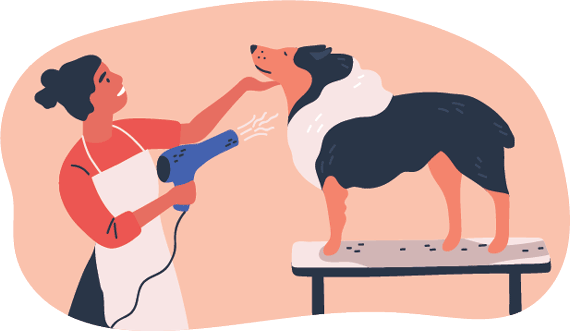
Good Studio / stock.adobe.com
Whether you shave or do not shave your Australian Shepherd, the best thing you can do is keep their coat well cleaned, dematted, and brushed.
Do Both! Shave and Don't Shave: The Hybrid Solution
Shaving is good if you want to expel heat and keep your dog cool. Keeping a full coat is good if you want to keep your dog warm and protected from the elements. What if there was a way that you could do both?
Natural on top, trimmed underneath. A balanced approach might work for you.
Since rain, sleet, snow, and sun come from above, why not keep a full coat on top to provide the benefits of guard hairs and full insulation to repel water and retain heat. Sure, you would still brush them well to maximize cooling when it's needed but they'd also have added protection from water, wind, cold, UV rays, and debris. It's not as cooling as being shaved on top, but what if you then trimmed the underside short.
You could go with a short clip from under the chin to where it starts to get long down the throat, the chest, the stomach, and under the arms. Just to make sure that the dog's heat could be conducted most efficiently down into a nice cool floor you could also use a deshedding tool to make sure that the undercoat itself was thinned out as much as possible. You know how much dog's love to spread out on a cool floor. By trimming the underside short and thinning out the extra "brush" in the undercoat, it improves the efficiency and speed of the cooling effect for your Aussie.
This works as well on kitchen tile as it does on a shady patch of grass, but can also be used in conjuction with a cooling pad. If you live in an area where it is hot during the day and cold at night you could compensate with a dog bed, if you don't have one already, or even a heating pad if necessary.
Hopefully, your groomer could do a transition where the coat goes from long to short so it looks good without being too abrupt.
So What's the Final Rule About Shaving an Australian Shepherd?
The bottom line is that there is no general rule of thumb for shaving an Australian Shepherd. Neither shaving or not shaving is good or bad, right or wrong. They are two different approaches to solving a problem. Each has benefits and drawbacks, advantages and trade-offs that have to be accounted for and balanced against a wide range of competing needs.
The benefit or risk of grooming is very much an individual decision and should be based on your dog's specific needs. If you have questions or concerns, you can consult your vet or your groomer for advice, but in the end, as a responsible owner, you have to make the choice that is best for your Aussie.
For more information about dog coats and thermal regulation see these in-depth articles:
To Shave or Not to Shave – A Look Into the Literature About Dog's Thermal Regulation, Coat Growth and More by Mia Overnas
A Deeper Look Into the Coat's Role in the Dog's Thermal Regulation by Mia Overnas
Have Dog Training Questions?
Check out these introductory dog training videos...
I want my dog to stop being aggressive.
I want some help training my new puppy.
I want my dog to stop barking at everything.
Get Australian Shepherd Info, Website Updates, Special Offers, and Cartoons...
FREE GIFT
You'll also receive a free copy of the ebook
My Everyday Dog Training Tools
by professional dog trainer Daniel Abdelnoor, "Doggy Dan"
